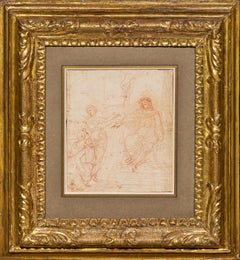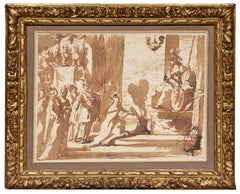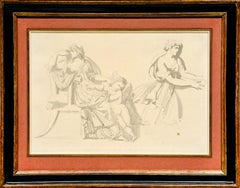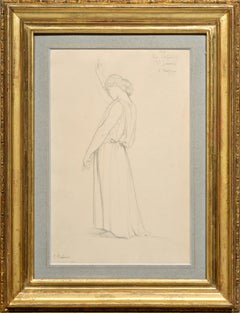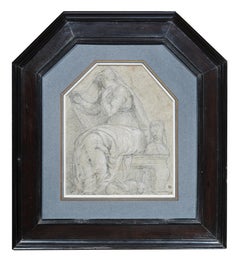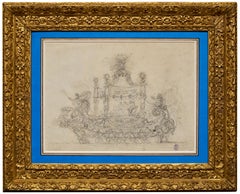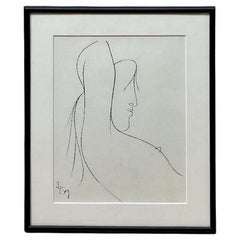Stephane Renard Fine Art Figurative Drawings and Watercolors
to
11
4
1
Overall Width
to
Overall Height
to
13
2
1
1
8
14
1
10
6
13
9
6
4
4
4
2
1
1
1
1
7
6
3
2
2
1
1
1
1
14
1
16
Studies for the Judgment of Solomon, a double-sided drawing by Simone Cantarini
Located in PARIS, FR
In this double-sided red chalk study, Simone Cantarini offers us a double reflection on the theme of the Judgment of Solomon. This sheet reveals his precise style and his sense of de...
Category
1640s Old Masters Figurative Drawings and Watercolors
Materials
Chalk, Laid Paper
Allegory of the Treaty of Angoulême, a drawing attributed to Donato Mascagni
Located in PARIS, FR
We would like to thank Mrs. Ursula Verena Fischer Pace for suggesting the attribution to Donato Arsenio Mascagni.
We were immediately seduced by the rich tonalities of this allegory...
Category
1620s Old Masters Figurative Drawings and Watercolors
Materials
Ink
Frieze of antique figures, a drawing by the sculptor Antoine-Denis Chaudet
Located in PARIS, FR
Faithful to the neo-classical taste, sculptor Antoine-Denis Chaudet presents us with a frieze of antique figures executed in gray wash over pencil strokes, which is likely inspired b...
Category
Early 1800s Old Masters Figurative Drawings and Watercolors
Materials
Paper, Pencil, Ink
A Study for the Angel of Saint-Severin church in Paris, by Paul Flandrin
Located in PARIS, FR
After the restoration of the Saint-John chapel’s frescoes at the Saint-Severin church in Paris in 2022, the drawing presented here is a moving testimony to their creative process. It...
Category
1840s Old Masters Figurative Drawings and Watercolors
Materials
Chalk
Allegory of Chastity, a drawing attributed to G. Porta with great provenance
Located in PARIS, FR
This magnificent drawing from the Venetian Renaissance intrigues us in many ways. It depicts an allegorical composition whose meaning partly escapes us: a veiled figure seated on a stone bench (which we have identified as Chastity), seems to be turning away from a woman's bust beside her, below which are two rabbits, a traditional allegory of fertility, but also sometimes of lust.
This drawing, executed on blue paper, undoubtedly belongs to the Venetian Renaissance. The inscriptions on the back of the old mounting board indicate the various attributions considered by its last owner, the British painter and art historian Sir Lawrence Gowing. We have retained the attribution to Giuseppe Porta proposed by art historian John Arthur Gere as the most relevant.
We were incredibly fortunate to find a hexagonal frame of a very similar format for this drawing, the upper corners of which were formerly cut (irregularly). This 17th-century Dutch frame comes from an aristocratic collection in Lombardy, and creates a kind of fascinating chase around this Venetian drawing...
Category
16th Century Figurative Drawings and Watercolors
Materials
Chalk
A dazzling Venetian Regatta Boat Study attributed to Alessandra Mauro
Located in PARIS, FR
This stunning Baroque study depicts a regatta boat, a type of vessel developed in eighteenth-century Venice for the regattas organized by the Serenissima during visits by royalty and princes. We propose to link this drawing to the work of Alessandro Mauro, an artist who specialized in this type of composition, as illustrated by a drawing from him at the Metropolitan Museum.
1. Description of the boat
The greatest decorative fantasy reigns in this preparatory study, which blends mythological and exotic elements with references to ancient Egypt. Our drawing is probably an initial thought, destined to be refined and clarified later in pen and ink (as evidenced by the ink stain in the lower right). A quadriga of seahorses guided by Neptune stands at the stern of the boat, shown well above the waterline (perhaps to outline its empty volume). One of the seahorses is ridden by a newt, while Amphitrite lies at the feet of the sea god.
The center of the boat is occupied by a vast baldachin resting on four atlantes and surmounted by a figure riding an animal (a dragon?). Three figures sit beneath the canopy, one of them on a griffin-shaped seat. This allusion to Egyptian antiquity echoes the winged sun (sometimes a symbol of the god Horus, as in the temple of Edfu in Egypt) that adorns the sides of the promontory on which this baldachin rests.
Another flag-bearer figure crouches at the stern of the boat on a raised seat, on the reverse of which is a crowned mermaid whose arm, extended backwards, rests on a mascaron decorated with a radiant face (Helios?) and whose torso surmounts an elephant's head. The heads of the rowers and their oars are sketched all along the boat, whose sides are embellished with elongated naiads.
2. The Venetian regatta boats
An exhibition held in 2013 at the Ca' Rezzonico (the Venetian eighteenth-century museum) paid tribute to these regatta boats through studies and prints depicting them. The regattas organized by the Serenissima in honor of visiting princes and sovereigns were among the most spectacular ceremonies in Venice. Some important artists of the 18th century contributed to the creation of these extravagant boats which were given exotic names such as bissona, malgarota or peota.
The specialists in this field were Andrea Urbani and the brothers Alessandro and Romualdo Mauro. They were born into a family of theater decorators in Piedmont, but little is known about their detailed biography. Alessandro was the architect of the Dresden opera house and of the St. Samuel Theater in Venice (in collaboration with his brother Romualdo), but also worked as stagehand and set designer in Vienna, Rome and Turin. A drawing produced around 1737 from the Metropolitan Museum (7th photo in the gallery) bears witness to his activity as a regatta boat designer.
This drawing is a much more elaborate version than the one presented here, having been entirely reworked in brown ink. However, a figure at the bow of the boat, executed solely in black chalk, still bears witness to a technique similar to that of our drawing.
It is difficult to know whether the boat depicted in our drawing was a project for an actual boat or whether it remained in the planning stage, but the front of our boat (Neptune and the quadriga of seahorses ridden by a newt) bears several similarities to that of a parade boat depicted in the print published by Michele Marieschi entitled Regatta on the Grand Canal, between the Foscari and Balbi Palaces (last photo in the gallery). This print is dated 1741, which could confirm that our work dates from around 1740.
The area between Neptune and the quadriga that precedes him on this strange paddle-boat appears to be partially submerged, confirming that the waterline of our boat was probably intended to be much lower than the one shown in our drawing.
The Correr Museum’s collection holds one of the most important collection of engravings and drawings devoted to these specifically Venetian Baroque productions. These boats were intended to last the duration of a festival. Today, they are only documented by preparatory drawings or prints that testify to the sumptuousness of their decoration. This taste for regatta boats lasted throughout the Venetian eighteenth century, and the conception of regatta boats also attracted great masters such as Giambattista Tiepolo, Francesco Guardi or Giambattista Piranesi...
Category
Mid-18th Century Old Masters Figurative Drawings and Watercolors
Materials
Chalk
The Martyrdom of Saint Bartholomew, a preparatory drawing by Alessandro Casolani
Located in PARIS, FR
This powerful pen and brown ink wash drawing is a study for an altarpiece depicting The Martyrdom of Saint Bartholomew. Signed and dated 1604, it was painted at the end of his life b...
Category
Early 1600s Old Masters Figurative Drawings and Watercolors
Materials
Ink, Pen
Judith and Salome, a pair of oil paintings on canvas by Francesco Conti
Located in PARIS, FR
This widely referenced pair of paintings is one of Francesco Conti’s most successful productions. Francesco Conti is one of the finest painters of 18th-century Florence. In the shimmering colors typical of his best work, he represents two opposite characters from the Bible: the virtuous Judith, whose courage saves her people by cutting off the head of the invader Holofernes, and the depraved Salome, who under the influence of her mother becomes responsible for the beheading of the prophet John the Baptist.
The artist's talent lies in his ability to treat these two macabre subjects with a light touch, presenting us with two attractive women who seem to twirl with glee amidst the severed heads...
1. Francesco Conti, the “Florentine Tiepolo”
Francesco Conti is a major painter of the Florentine school of the 18th century; he can even probably be considered, along with Giovanni Domenico Ferretti (1692-1768), as one of the two main painters of the second quarter of the Florentine 18th century.
Born in Florence in 1682, Francesco Conti began his apprenticeship in the workshop of Simone Pignoni (1611 - 1698), a disciple of Francesco Furini; he was also influenced by the Venetian Sebastiano Ricci. A protégé of Marquis Riccardi, he accompanied him to Rome between 1699 and 1705, where he frequented Carlo Maratta's studio. He settled permanently in Florence in 1705.
Painted exclusively on canvas, the majority of his work consists of religious subjects, altarpieces or private devotional works. It is likely that Conti himself was a devout churchgoer, as evidenced by his affiliation, in the third decade of the eighteenth century, to the Society of the Disciples of Saint-John-the-Baptist, and his entry, at the end of his life, into the fraternity of the Venerable Society of the Holy Trinity.
In Florence, Conti worked for the Grand Duchy's major patrons, including the last Medici - in particular Giangastone and Annamaria Luisa, Electress Palatine - and confirmed his role as a reference painter under the Lorraine Regency, as master of the Public Drawing School, which was closely linked to the institute responsible for the manufacture of semi-precious stone mosaics, then located in the Uffizi complex.
Matteo Marangoni, an art critic of the early 20th century, praised his "brushwork full of elegance and true spirit of the 18th century", pointing out that Conti was "probably one of the best colorists" of the Florentine school of his time. These two characteristics led the art historian Paolo dal Poggetto to nickname him the "Florentine Tiepolo".
2. Judith and Salome, two biblical characters opposing each other
These two paintings form a pair presenting two biblical episodes, which have in common the depiction of a "heroine" carrying the severed head of a man.
While the Salome episode might at first appear to be an echo of the Old Testament story of Judith, each character is the exact opposite of the other. Judith, whose story is told in the Book of Judith, is a beautiful young widow from Bethulia who, accompanied by her maid, went into the camp of the invading Assyrians and won the confidence of Holofernes, the general commanding the enemy army. Invited to a great feast on the fourth evening, she took advantage of Holofernes' drunkenness to cut off his head. “She went up to the bedpost near Holofernes’ head, and took down his sword that hung there. She came close to his bed, took hold of the hair of his head, and said, “Give me strength today, O Lord God of Israel!” Then she struck his neck twice with all her might, and cut off his head. Next she rolled his body off the bed and pulled down the canopy from the posts. Soon afterward she went out and gave Holofernes’ head to her maid, who placed it in her food bag...
Category
1710s Old Masters Figurative Drawings and Watercolors
Materials
Canvas, Oil
Soldier begging for Mercy a preparatory study by Jean-Marc Nattier (1685 - 1766)
By Jean-Marc Nattier
Located in PARIS, FR
This rare drawing by Nattier is part of a set of preparatory studies executed in 1717 for one of the painter's first commissions, the painting commissioned by Tsar Peter I of Russia ...
Category
1710s Old Masters Figurative Drawings and Watercolors
Materials
Chalk
Three drawings by François Boucher in a mounting by Jean-Baptiste Glomy
By François Boucher
Located in PARIS, FR
We would like to thank Juliette Parmentier-Courreau of the Custodia Foundation for her welcome and support during the consultation of Glomy’s Journal des Ouvrages.
This spectacularly large "feuille de desseins ajustés" commissioned by François Boucher from Jean-Baptiste Glomy is emblematic of the painter's art and mastery of rocaille. It is also fully representative of the taste of this period in the field of decorative arts. The largest of these three drawings, placed at the bottom of the composition, is particularly interesting: dating from around 1756, it constitutes a modello (apparently unpublished) for the frontispiece of the "Catalogue des tableaux de Monsieur de Julienne"), preserved in the Morgan Library in New York.
1. François Boucher, the master of French rocaille
The extraordinary career of Francois Boucher was unmatched by his contemporaries in versatility, consistency and output. For many, particularly the writers and collectors who led the revival of interest in the French rococo during the last century, his sensuous beauties and plump cupids represent the French eighteenth century at its most typical. His facility with the brush, even when betraying the occasional superficiality of his art, enabled him to master every aspect of painting – history and mythology, portraiture, landscape, ordinary life and, as part of larger compositions, even still life. He had been trained as an engraver, and the skills of a draftsman, which he imbued in the studio of Jean-Francois Cars (1661 – 1738), stood him in good stead throughout his career; his delightful drawings are one of the most sought-after aspects of his oeuvre.
As a student of Francois Lemoyne (1688 - 1737), he mastered the art of composition. The four years he spent in Italy, from 1727-1731, educated him in the works of the masters, classics and history, that his modest upbringing had denied him.
On his return to Paris in 1734, he gained full membership of the Royal Academy of Painting and Sculpture with his splendid Rinaldo and Armida (Paris, Musée du Louvre). Although, throughout his career, he occasionally painted subjects taken from the Bible, and would always have considered himself first as a history painter, his own repertoire of heroines, seductresses, flirtatious peasant girls and erotic beauties was better suited to a lighter, more decorative subject matter. His mastery of technique and composition enabled him to move from large scale tapestry...
Category
1750s Old Masters Figurative Drawings and Watercolors
Materials
Chalk, Ink
Study of a Fate at mid-body, a red chalk attributed to Giovanni da San Giovanni
Located in PARIS, FR
This spectacular red chalk drawing depicts an elderly woman, her eyes bulging, her hand stretched out towards the sky. This disturbing character, who seems close to dementia, and the elongation of her arm with its Mannerist overtones, plunge us into the Florentine artistic milieu of the first half of the 17th century. The proximity of this drawing to some characters in the fresco in the Pitti Palace representing The Muses, Poets and Philosophers chased from Parnassus, the last masterpiece of Giovanni da San Giovanni, leads us to propose an attribution to this artist and a dating of around 1635-1636.
1. Giovanni da San Giovanni, the painter of contradiction
We take here the title of the monography dedicated to the artist by Anna Banti in 1977, which remains the reference book for this artist. The son of a notary, Giovanni Mannozzi, known as Giovanni da San Giovanni, abandoned his studies to go to Florence at the age of sixteen, where he entered the studio of Matteo Rosselli (1578 - 1650) around 1609 and enrolled in the Academy of Drawing Arts in 1612. Around 1615 he produced his first known works, mainly frescoes for the city's tabernacles. He became famous in Florence for his originality, combining an obsessive application to the study of drawing and the reading of poetry and history with a disheveled appearance. Between 1619 and 1620 he decorated the facade of the Antella Palace in Piazza Santa Croce, a decoration that still partly survives today.
The death of Cosimo II in 1621 put an end to the Florentine building activity and Giovanni da San Giovanni left for Rome to find other sponsors with the painter Francesco Furini...
Category
17th Century Old Masters Nude Drawings and Watercolors
Materials
Chalk
Study for a Frontispiece, a baroque drawing by Giovanni Antonio Pellegrini
By Giovanni Antonio Pellegrini
Located in PARIS, FR
This masterly frontispiece study, executed with a very sure hand, testifies to the survival of the great Baroque taste in 18th century Venice. It could be one of the very last works by Giovanni Antonio Pellegrini: the few lines that cross the papal arms evoke those of Benedict XIV, who became pope in 1740, one year before the artist's death.
1. Giovanni Antonio Pellegrini and the European influence of Venetian history painting in the 18th century
Giovanni Antonio Pellegrini was born in Venice in 1675 and trained in the studio of the Milanese painter Paolo Pagani (1655 - 1716). Pagani, who had been living in Venice since 1667, took him to Moravia and Vienna from 1690 to 1696. After a stay in Rome from 1699 to 1701, Pellegrini married Angiola Carriera in 1704, the sister of the great pastelist Rosalba Carriera.
From 1708 onwards, Pellegrini left Venice and began an extensive tour of Europe: he worked in England between 1708 and 1713, where he met great success, particularly at Kimbolton Castle and Castle Howard. He then worked in Germany and the Netherlands, then in Bohemia and Austria, before returning briefly to England in 1719. In 1720 he was in Paris where he decorated the ceilings of the Royal Bank for John Law...
Category
1740s Old Masters Figurative Drawings and Watercolors
Materials
Ink
Three studies executed in the Pitti Palace in 1761 by Jean-Honoré Fragonard
By Jean-Honoré Fragonard
Located in PARIS, FR
This brilliant study sheet, of which we present here a counterproof, is a souvenir of Fragonard's return journey from Italy. Between April and September 1761, he accompanied the abbot of Saint-Non on his way back to France. Three studies after the masters taken from the Pitti Palace’s gallery in Florence are gathered on this sheet. Although The Ecstasy of Saint Margaret...
Category
1760s Old Masters Figurative Drawings and Watercolors
Materials
Carbon Pencil
Study for « The Chinese Masquerade » by Jean-Baptiste Pierre (1714 - 1789)
By Jean-Baptiste Pierre
Located in PARIS, FR
Arriving in Rome in June 1735 as a resident at the Royal Academy, Pierre was unable to attend the Winter Carnival festivities of 1735, which he nevertheless immortalised in an engrav...
Category
1730s Old Masters Figurative Drawings and Watercolors
Materials
Graphite
Aranea diadima a study by Walter Spies, an artist living in Indonesia in the 30s
Located in PARIS, FR
Walter Spies was one of the first Europeans to settle in Bali after a stay in Java. He greatly contributed to the discovery and popularization of Balinese...
Category
1920s Art Deco Animal Drawings and Watercolors
Materials
Watercolor
Study in the Antique Style, a neoclassical drawing by Augustin Pajou
Located in PARIS, FR
In this lively and fresh drawing, probably taken from one of the artist's notebooks, Pajou presents us with a composition freely inspired by antiquity, as a souvenir of a visit to th...
Category
1750s Old Masters Figurative Drawings and Watercolors
Materials
Ink
Related Items
Nude Woman Profile Drawing by Radoczy
By Albert Radoczy
Located in Pasadena, CA
Reclining Female figure, original signed line drawing, in pencil and ink by Albert Radoczy.
Albert Radoczy was a master at exploring the female form. Throughout his career, his draw...
Category
1950s Modern Figurative Drawings and Watercolors
Materials
Ink, Pencil
$304 Sale Price
20% Off
H 14.38 in W 11.88 in D 0.88 in
"Self Portrait Conte Sketch" rare Ben Fenske work on paper - academic study
By Ben Fenske
Located in Sag Harbor, NY
A colorful self-portrait from Ben Fenske, staring at the viewer straight-on. Hues of red dominate.
Unframed.
Ben Fenske (b. 1978) although a native of Minnesota, and has been worki...
Category
Early 2000s Academic Portrait Drawings and Watercolors
Materials
Paper, Conté
$1,200
H 25.5 in W 19 in
18th Century School, Courtyard of a palazzo, Architectural Capriccio, drawing
Located in Paris, FR
18th Century french School,
Courtyard of a ruined palazzo, An Architectural Capriccio,
Pen and black ink and black ink wash on paper
17 x 12 cm
In good condition
Framed : 32 x 26 c...
Category
1780s Old Masters Interior Drawings and Watercolors
Materials
Ink
Napoleon at the Head of His Grande Armée, His Generals and the Prussian Hussars
Located in Cotignac, FR
Pencil, chalk and watercolour depiction of Napoleon at the head of his generals by French artist Jean Ducel. The work is signed bottom right.
A bold and graphic depiction of Napoleo...
Category
Late 20th Century Outsider Art Figurative Drawings and Watercolors
Materials
Chalk, Crayon, Cardboard, Pencil, Watercolor
Jean-Henri Cless (1774-1812) Portrait of a young woman, signed drawing
Located in Paris, FR
Jean-Henri Cless (1774-1812)
Portrait of a young woman in a landscape
signed "Cless fec" for fecit on the lower left
Brown ink and brown ink wash on paper
Size of the sheet : 31.5 x 22 cm
Size of the motive : 24.5 x 17 cm
very simply framed under glass without actual frame 32 x 22.5 cm
This pre...
Category
Early 1800s Old Masters Portrait Drawings and Watercolors
Materials
Ink, Pencil
Raven Reads the Lines: Chalk Drawing of Black Bird on Vintage Book Pages
Located in Hudson, NY
Raven Reads the Lines (Chalk Drawing of Black Bird on Vintage Book Pages) by Louise Laplante
chalk on vintage collaged book pages.
Artwork measures ...
Category
2010s Contemporary Figurative Drawings and Watercolors
Materials
Paper, Chalk
MB 827 (Contemporary Life Drawing of Two Nude Males by Mark Beard)
By Mark Beard
Located in Hudson, NY
Academic life drawing of two nude males with charcoal and graphite by Mark Beard, "MB 827"
graphite, Conte crayon and charcoal on Arches paper
29.75 x 21.75 inches unframed
Signed, l...
Category
2010s Contemporary Nude Drawings and Watercolors
Materials
Conté, Charcoal, Archival Paper, Graphite
$1,650
H 29.75 in W 21.75 in
Black Bird Tours Around the World (Chalk Drawing over Collaged Sheet Music)
Located in Hudson, NY
Figurative chalk drawing of grey, black, and teal clouds and birds silhouetted on collaged vintage music pages
'Black Bird Tours Around the World ' by Louise Laplante in 2022
silhouettes made with chalk on vintage collaged music pages
24 x 30 inches unframed, 27.5 x 33.5 inches in natural light wood frame with non-glare plexi
Louise Laplante bridges the past and present with mixed media drawings made with figurative charcoal silhouettes juxtaposed on collaged sheets of vintage paper. Finding beauty in forgotten or discarded sheets of ephemera, Laplante uses it as a guide for playful compositions of stenciled birds in mid-flight, drifting feathers, or taxidermized deer heads in rich pastel. A final burst of wistful linework glides over the pastel forms, accentuating her subject’s movement while adding another layer of texture. In this particular work, the artist using a palette of black, grey and shades of blue and teal to compose a balanced graphic of fluffy clouds extending above a single black bird. In certain segments the stenciled images are delicately brushed over with a thin wisp of chalk which adds a delicate textured effect to the drawing. The drawing is framed with a light wood frame and has non-glare plexi glass galzing.
About the artist:
Interested in blending the old world with the new, mixed media artist Louise Laplante combines her original images with ephemera of the past, enticing a conversation about it’s “relevancy to the present.” Her compositions begin with vintage book pages, personal handwritten letters, sheet music, or instruction from old guides on etiquette or science. While the text itself is weighted with reference to a particular subject, the visual of the typed or handwritten words and printed illustrations establish a unique pattern. These layered backgrounds are superimposed with opaque charcoal drawings that are inspired by the themes read between the lines. Most recently, the artist has opted for larger scale work, combining multiple sheets of vintage paper to expand her unique motifs. Laplante exhibits across the Northeast and has shown with Carrie Haddad for more than ten years.
Artist Statement:
My work connects the texts, and ideas, in the vintage book, music or correspondence pages, with images those words evoke to comment on how the past still resonates, whether we are aware of it or not.
It is informed by my love for old paper, letters, books and images, both as reminders of the past and as bits of pattern, tone, line and shape. The text on them acts as both content and visual device. With each work, I select, arrange and collage these pieces creating both a support and pattern building on it with motifs that are suggested by words on the papers. Although I often start with an agenda I always allow each work to build its own image.
Artist Resume:
Education
MA in Fine Art, State University of New York at Albany, New York
BFA, College of New Rochelle, New Rochelle, New York
Studied, Art Institute of Boston, Boston, Massachusetts
Exhibitions
2019 Mediums of Exchange, Lehman College Art Gallery, Lehman College, CUNY, Bronx, New York
2018 Figures We Fancy, Carrie Haddad Gallery, Hudson, New York
Shelter, A.P.E. Gallery, Northampton, Massachusetts
Material Flow: Rhythm in Collage and Sculpture, Pratt Gallery, Goddard College, Plainfield, Vermont
2017 Abstractions in Black and White, Gallery 175 Pawtucket, Rhode Island
Blanche Ames National, Borderlands, North Easton, Massachusetts
Five Points Biennial, Five Points Gallery, Torrington, Connecticut
A Declaration of Sentiments: Reflections on the Centennial of Women’s Right to Vote in NYS, Athens
Cultural Center, Athens, New York
2016 Winter Exhibit, Carrie Haddad Gallery, Hudson, New York
2015 Boston Biennial 4, Atlantic Gallery, Boston, Massachusetts
Drawing, Carrie Haddad Gallery, Hudson, New York
Taking Root: Caniskek and the Meeting of Two Worlds, Athens Cultural Center, Athens, New York
North Northeast, Brattleboro Museum and Art Center, Brattleboro, Vermont
NBMMA 45th Exhibition, New Britain Museum of American Art, New Britain, Connecticut
2014 New Directions ’14, Barrett Art Center, Poughkeepsie, New York
Connecticut Women Artists – 85th National, Slater Memorial Museum, Norwich, Connecticut
New England Collective V, Galatea Fine Art, Boston, Massachusetts
Boston Biennial 3, Atlantic Works Gallery, Boston, Massachusetts
2013 Storytellers and Conjurers, Carrie Haddad Gallery, Hudson, New York
2012 Works on Paper, Carrie Haddad Gallery, Hudson, New York
Drawing, b.j. spoke gallery, Huntington, New York
Strange Glue, Thompson Gallery, Weston, Massachusetts
Silhouette, A.P.E., Northampton, Massachusetts
The Cadence of Familiarity, Krauss Gallery, Providence, Rhode Island
2011 20th Anniversary Exhibition, Carrie Haddad Gallery, Hudson, New York
Paperworks, Paper City Studios, Holyoke, Massachusetts
Small Works, Towne Gallery, Wheelock College, Boston, Massachusetts
2010 Text/Context, McCoy Gallery, Merrimack College, North Andover, Massachusetts
A Community of Artists, Danforth Museum of Art, Framingham, Massachusetts
Here and Gone: Presence, Absence, Memory and Time, Amy H. Carberry Fine Art Gallery,
Springfield Technical Community College, Springfield, Massachusetts
2009 Dreamscape, Carrie Haddad Gallery, Hudson, New York
2008 Small ’08, Wunderarts Gallery, Amherst, Massachusetts
Interaction: Louise Laplante and Liz Chalfin, Wunderarts Gallery, Amherst Massachusetts
Artists and Books, Art Complex Museum, Duxbury, Massachusetts
One Night, Pivot Gallery, Florence, Massachusetts
2007 20 Artists X 2 Feet, Wunderarts Gallery, Amherst, Massachusetts
Biennial 2007, New Hampshire Art Institute, Manchester, New Hampshire
Salon, Clark Gallery, Lincoln, Massachusetts
2006 Small: 20 Artists X 2 Feet, Wunderarts Gallery, Amherst, Massachusetts
Salon, Clark Gallery, Lincoln, Massachusetts
2004 On Paper, Carrie Haddad Gallery, Hudson, New York
Encaustics, Carrie Haddad Gallery, Hudson, New York
New Acquisitions, University Gallery, University of Massachusetts, Amherst, Massachusetts
2003 Hart Gallery...
Category
2010s Contemporary Animal Drawings and Watercolors
Materials
Paper, Chalk
$3,500
H 27.5 in W 33.5 in D 1.5 in
France 18th Century, Pastorale (Arcadian Landscape), original drawing
Located in Paris, FR
France 18th Century,
Pastorale (Arcadian Landscape)
Black chalk and heightenings of white gouache on blue-grey paper
19 x 31 cm
Framed : 34.5 x 46.5 cm
The atmosphere and the subje...
Category
1760s Old Masters Landscape Drawings and Watercolors
Materials
Chalk
$1,259
H 7.49 in W 12.21 in
La Femme Muse /// Allegorical Symbolism Romantic Old Masters European Drawing
Located in Saint Augustine, FL
Artist: Unknown (Likely French, 18th Century)
Title: "La Femme Muse"
*No signature found
Circa: 1780
Medium: Original Pastel Drawing on heavy laid paper
Frami...
Category
1780s Old Masters Figurative Drawings and Watercolors
Materials
Pastel, Laid Paper
$1,200 Sale Price
78% Off
H 15 in W 12.5 in
MB 076 A&B (Double Sided Figurative Charcoal Drawing of Male Nudes)
By Mark Beard
Located in Hudson, NY
Figurative drawing of male nudes made with graphite, charcoal, and conte crayon on Arches paper
30 x 22 inches, unframed
One piece of 30 x 22 inch Arches. Two drawings, one on either...
Category
Early 2000s Modern Nude Drawings and Watercolors
Materials
Charcoal, Archival Paper, Graphite
$1,600
H 30 in W 22 in
St. John the Baptist in the wilderness , Ecce Agnus Dei (Behold the Lamb of God)
By Giovanni Francesco Barbieri (Il Guercino)
Located in Middletown, NY
Pen and sepia ink and wash on vellum, 8 7/8 x 10 1/2 inches (225 x 267 mm). In very good condition with some modern notations in pencil on the verso, minor cockling, and a 1-inch hor...
Category
Mid-17th Century Old Masters Portrait Drawings and Watercolors
Materials
Ink, Watercolor, Vellum, Pencil
$650
H 8.88 in W 10.5 in
